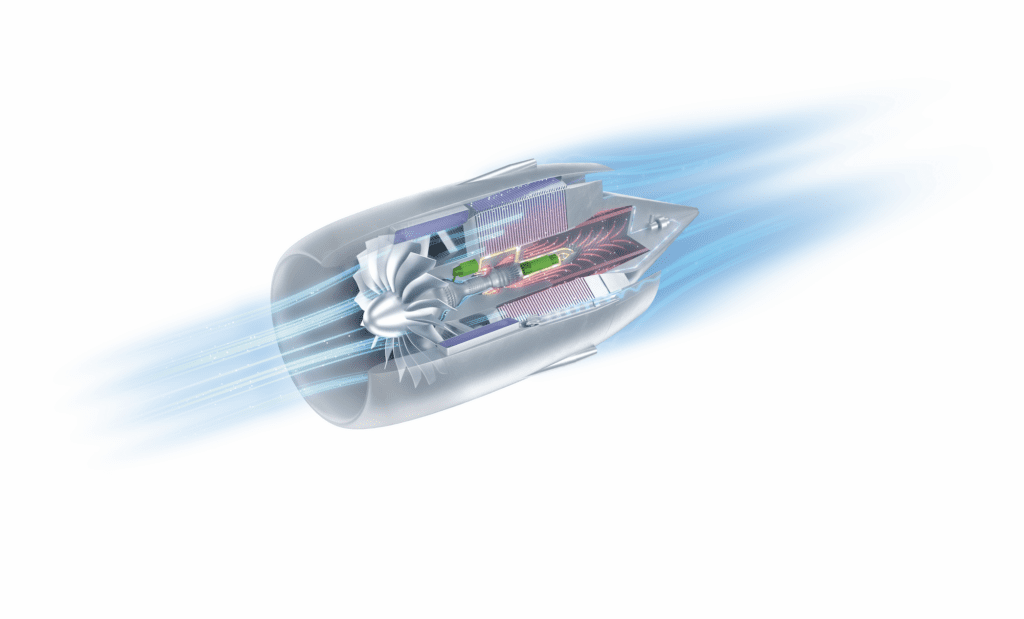
MTU Aero Engines is coordinating a newly formed consortium of aerospace technology companies to develop hybrid-electric and water-enhanced turbofan technology. The consortium includes Pratt & Whitney, Collins Aerospace, GKN Aerospace, Airbus, the University of Stuttgart, and others. (Photo: MTU Aero Engines)
Various aerospace technology companies have come together in a collaborative partnership to develop water-enhanced and hybrid-electric propulsion systems for aircraft. The partnership, coordinated by MTU Aero Engines AG (MTU), is supported by the European Union Clean Aviation Joint Undertaking (Clean Aviation) and includes partners like Collins Aerospace (Collins), University of Stuttgart, Pratt & Whitney, GKN Aerospace, and Airbus. The goal of this consortium is to reduce CO2 emissions from aircraft by up to 25%.
The collaboration between leading aerospace companies is needed for the aviation industry to become more sustainable, especially as pressure from both regulators and the public over aircraft emissions intensifies. As Geoff Hunt, Pratt & Whitney’s Senior Vice President of Engineering and Technology, explained, “Given the challenge of reducing the environmental impact of aviation, cross-industry collaboration and public-private partnerships like Clean Aviation will play a vital role in delivering the technology breakthroughs needed to make net zero emissions aviation a reality.”
The group’s main focus is to use its combined knowledge, technology, and resources to support its Sustainable Water-Injecting Turbofan Comprising Hybrid-Electrics (SWITCH) project. It plans to use two innovative technologies—water-enhanced turbofans (WETs) and hybrid-electric propulsion—to reduce the carbon footprint of aircraft. A WET creates more efficient travel by recovering water vapor released from exhaust and inserting it back into the combustion chamber. The consortium plans to combine WET with a Pratt & Whitney GTF power plant equipped with electric motors designed to improve efficiency during all stages of the flight, especially taxiing.
Researching and developing more efficient propulsion systems is key to improving the sustainability of air travel. As Sabine Klauke, Chief Technology Officer at Airbus, explained, “New propulsion technologies will play an important role in achieving aviation’s net-zero goals, along with new aircraft designs and sustainable energy sources.” The consortium of aerospace companies considered the value of these sustainable energy sources, as any technologies created by SWITCH will be compatible with sustainable aviation fuel (SAF).
Each member of the consortium brings its assets and expertise to support the SWITCH project. Airbus has valuable insights in integrating these new technologies to current aircraft. Specifically, the aircraft manufacturer will assist in the evaluation of both aircraft designs and energy management systems. Meanwhile, Collins will supply the SWITCH program with power electronics, electric motor generators, DC distribution, and architectures for engine nacelles. Engine structures that can support the new technology, such as heat exchangers, will be provided by GKN Aerospace.
The consortium working on the SWITCH project is not the first program Clean Aviation has supported in recent times. As a public-private partnership partially supported by the European Union, it has backed several innovations aimed toward the improvement of air travel. Most recently, Clean Sky 2, a program of Clean Aviation, saw a successful maiden flight of its C295 Test Bed. This aircraft was given modifications aimed at reducing emissions and noise levels and is demonstrating promising new technologies.
Supported by powerful and successful aerospace companies, the SWITCH program is yet another project that aims to harness technology to create a cleaner future for the aviation industry. Receiving funding through 2025, the SWITCH team hopes to see positive results from the testing of its technology and the further application of its innovations to current aircraft.